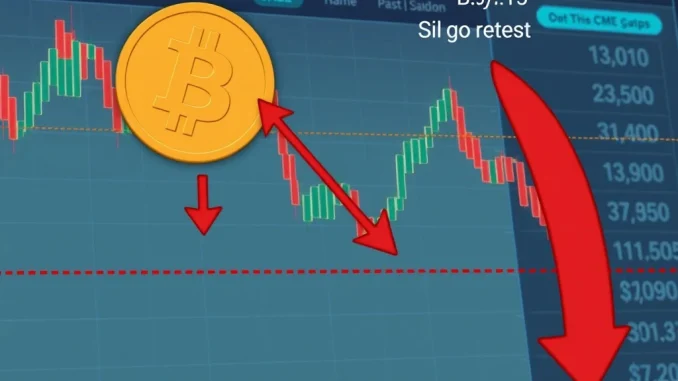
The cryptocurrency world is abuzz with cautious whispers as the Bitcoin price faces a pivotal moment. After a robust run, technical indicators are flashing warning signs, suggesting a potential short-term pullback for the world’s leading digital asset. Is a retest of the critical $115,000 level inevitable, or can Bitcoin defy the odds once more?
Why is Bitcoin Price Facing Pressure?
Recent market movements have seen the Bitcoin price struggle to decisively break past the $120,000 mark since mid-July. Instead, it has consolidated within a tight $115,000–$120,000 range. This consolidation isn’t necessarily bearish on its own, but it coincides with several technical patterns that analysts are closely watching. While the long-term bullish trend for Bitcoin remains largely intact, the immediate future appears clouded by weakening momentum and echoes of historical price behavior. Traders are now weighing the increasing likelihood of a retest of significant support levels [1].
Understanding Bearish RSI Divergence: A Key Signal
One of the most concerning signals emerging from the charts is a hidden bearish RSI divergence. For those new to technical analysis, the Relative Strength Index (RSI) is a momentum oscillator that measures the speed and change of price movements. A divergence occurs when the price of an asset moves in one direction, but its RSI moves in the opposite direction, often signaling a potential reversal. In Bitcoin’s case, we’ve observed the price forming higher highs, while the RSI has simultaneously formed lower highs. This particular pattern was previously noted in March 2024, preceding a significant 20% correction [2]. The recurrence of this divergence raises legitimate concerns that a similar short-term decline could materialize, pushing the Bitcoin price lower.
The Gravity of CME Gaps: Will Bitcoin Fill the Void?
Adding to the bearish sentiment are the persistent open CME gaps. These gaps represent price discrepancies that occur when the Chicago Mercantile Exchange (CME) Bitcoin futures market opens or closes at a different price than where it last traded, often due to weekend trading in the spot market. Historically, Bitcoin has shown a tendency to ‘fill’ these gaps, meaning its price often gravitates back to these unfilled levels. Currently, a notable CME gap exists between $114,380 and $115,635 [3]. What makes this particularly compelling is that seven out of nine CME gaps recorded in 2025 have already been closed, significantly amplifying the probability of a near-term revisit to this $115,000 threshold. This potential ‘gap fill’ could act as a strong magnet for the Bitcoin price, pulling it down to those levels.
Broader Bitcoin Market Analysis: What the Indicators Say
Beyond RSI and CME gaps, a comprehensive Bitcoin market analysis reveals other indicators supporting a cautious outlook. Anonymous crypto analyst Gaah highlighted that the Index Bitcoin Cycle Indicator (IBCI) has entered a ‘distribution zone.’ This zone is historically associated with market peaks and increased volatility, signaling a period where assets might be changing hands from stronger to weaker holders. While the current IBCI reading at 80% is below the 100% levels seen during previous cycle tops, it still indicates elevated corrective risk. Furthermore, supporting metrics like the Puell Multiple and STH-SOPR (Short-Term Holder Spent Output Profit Ratio) remain below mid-levels, suggesting that widespread retail speculation and significant miner profit-taking haven’t reached critical mass yet [4]. This implies that the current phase is more of a warning signal, rather than a definitive end-of-cycle top, providing valuable context for the crypto market outlook.
Navigating the Current Crypto Market Outlook: What’s Next?
On-chain data from Mitrade further underscores the market’s current indecision, with Bitcoin having been confined to its $115K–$120K range for ten consecutive days. Key moving averages, specifically the 50 and 100-period Simple Moving Averages (SMAs), are clustered near the $110K–$113K zone. This reinforces the significance of the $115K–$118K area as a crucial battleground for bulls and bears. A sustained break below $115,724 could indeed trigger a retracement towards $113K. Conversely, a decisive close above $122,000 might reignite bullish momentum and pave the way for a push towards $130K [5]. Analyst Axel Adler also noted that the 30-day supply active metric has edged up to +2.4%, indicating early-stage distribution. However, this figure is still far below the 18–20% peaks observed in prior bull cycles, suggesting the market isn’t yet in a full-blown distribution phase [6]. The broader crypto market outlook remains in a transitional phase. A breakout above $122,000, potentially fueled by renewed ETF inflows or positive macroeconomic catalysts, could reignite strong bullish momentum. However, the current lack of conviction among traders highlights the need for further clarity. As the market processes these varied signals, the $115K threshold will be absolutely pivotal in determining Bitcoin’s next major directional move [7].
While the long-term narrative for Bitcoin remains strong, the immediate future presents a challenging landscape. The confluence of a hidden bearish RSI divergence, persistent open CME gaps, and indicators suggesting a distribution zone paints a cautious picture. A retest of the $115,000 support level appears increasingly likely, offering both a potential buying opportunity for long-term holders and a moment of truth for short-term traders. Monitoring volume, ETF flows, and the ability of Bitcoin to reclaim key resistance levels will be crucial in the coming days. The market is at a crossroads, and how Bitcoin navigates these technical headwinds will set the tone for its next significant move.
Frequently Asked Questions (FAQs)
1. What is a bearish RSI divergence and why is it significant for Bitcoin?
A bearish RSI divergence occurs when Bitcoin’s price makes higher highs, but its Relative Strength Index (RSI) makes lower highs. This indicates weakening momentum despite price gains and often signals a potential short-term price reversal or correction, as seen in March 2024 before a 20% drop.
2. What are CME gaps and how do they affect Bitcoin’s price?
CME gaps are price discrepancies on the Chicago Mercantile Exchange’s Bitcoin futures chart, typically created when the market opens or closes at a different price than its last trade. Historically, Bitcoin’s spot price tends to move to ‘fill’ these gaps, acting as a magnet for price action and often leading to retests of those levels.
3. What is the significance of the $115,000 level for Bitcoin?
The $115,000 level is significant because it aligns with a notable open CME gap ($114,380-$115,635) that Bitcoin has a historical tendency to fill. It also represents a critical support zone that, if broken, could lead to further retracement.
4. Are current market signals indicating an end to Bitcoin’s bull run?
Not necessarily. While indicators like bearish RSI divergence and the IBCI entering a ‘distribution zone’ suggest short-term corrective risk, other metrics like the Puell Multiple and STH-SOPR are not yet at levels typically seen at major cycle tops. This implies the current phase is more of a warning signal or consolidation, rather than a definitive end to the long-term bull trend.
5. What technical levels should Bitcoin traders watch?
Traders should closely monitor the $115,000 support level, especially the $115,724 mark, as a sustained break below it could trigger a retracement to $113,000. On the upside, a decisive close above $122,000 is crucial for reigniting bullish momentum and a potential push towards $130,000.



